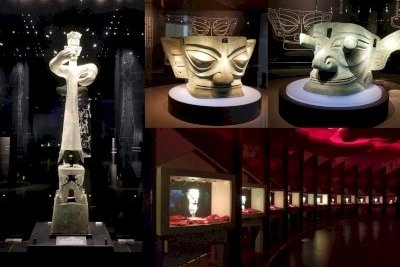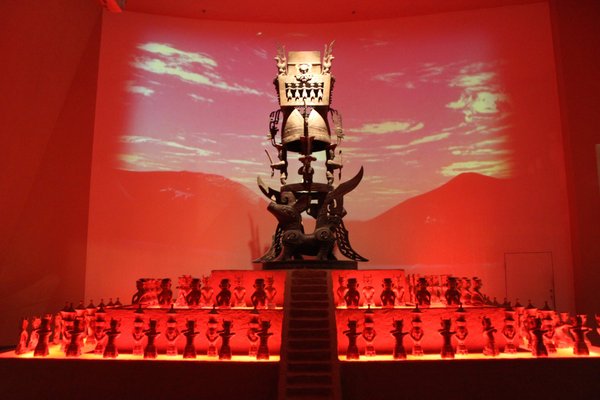China
Archaeological Sites of the Ancient Shu State
The Archaeological Sites of the Ancient Shu State are an outstanding representative of the Bronze Age Civilization of China, East Asia and even the world.
Sanxingdui, located in the western suburb of Guanghan city, Jinsha, located in the west of Chengdu city, and several Joint Tombs of Boat-shaped Coffins, reflect the unique urban planning concept, spatial sens,e and social structure of ancient Shu State, a typical representative of the Bronze Civilization of the Yangtze River Valley during 1900 B.C.-400 B.C.
Site Info
Official Information
- Full Name
- Archaeological Sites of the Ancient Shu State: Site at Jinsha and Joint Tombs of Boat- shaped Coffins in Chengdu City, Sichuan Province; Site of Sanxingdui in Guanghan City, Sichuan Province 29C.BC-5C.BC (ID: 5816)
- Country
- China
- Status
-
Nominated 2028
Site history
History of Archaeological Sites of the Ancient Shu State
- 2024: Preliminary Assessment
- 2013: Revision
- 2008: Added to Tentative List
- Added to tentative list
- Type
- Cultural
- Criteria
- i
- ii
- iii
- v
Links
- UNESCO
- whc.unesco.org
- Official
-
- jinshasitemuseum.com — Jinsha Site Museum
All Links
UNESCO.org
- whc.unesco.org — whc.unesco.org
Official Website
- jinshasitemuseum.com — Jinsha Site Museum
News Article
- Nov. 18, 2023 edition.cnn.com — ‘Faces of Sanxingdui’: Bronze Age relics shed light on mysterious ancient kingdom
- March 25, 2021 smithsonianmag.com — 3,000-Year-Old Gold Mask, Silk Linked to Enigmatic Civilization Found in China
Community Information
- Community Category
- Archaeological site: Far Eastern
Travel Information
Recent Connections
News
- edition.cnn.com 11/18/2023
- ‘Faces of Sanxingdui’: Bronze Age …
- smithsonianmag.com 03/25/2021
- 3,000-Year-Old Gold Mask, Silk Lin…
Recent Visitors
Visitors of Archaeological Sites of the Ancient Shu State
- Alejandro Lau
- Bin
- Boj
- Dwight Zehuan Xiao
- Elisabeth Fransisca Situmorang
- Els Slots
- Errol Neo
- henryjiao18
- Joel on the Road
- Jonas Kremer
- Kasper
- Kevin McFarland
- Kristin
- lichia
- Lucio
- Ludvan
- Luke LOU
- nan
- Pchxiao
- ReallyDeepThoughts
- Sergio Arjona
- Shandos Cleaver
- Ssong.x
- Stanislaw Warwas
- Szucs Tamas
- Thomas Buechler
- Thomas van der Walt
- Xiquinho Silva
- Zhou Yan
- Zos M
Community Reviews
Show full reviewsZoë Sheng
Archaeological Sites of the Ancient Shu State
Archaeological Sites of the Ancient Shu State (Nominated)

This may be China's top tentative site, culturally. The main reason it's taking a backseat it probably because there are still lots of discoveries to be made. There are three sites to this place: Jinsha Museum in the west part of Chengdu, Joint Tombs of Boat-shaped Coffins are in Chengdu as far as I understand but I did not try to visit them, Sanxingdui in the nearby city of Guanghan. I have only been to the museums because they seem worth checking out.
Jinsha, easily reached by metro, nowadays only opens at 9am (I say this because a lot of info online is wrong because I think they used to open at 8am) and costs a whopping 100 entry (again, wrong/outdated info online everything). It's still worth the large ticket price considering you get to see the legendary Golden Sun Bird which now stands for the city icon. Hard to imagine it was only discovered in 2001 and has already made such an impact on the town. The Jinsha museum is right on top of the site and thus you would feel you have really "been" to the place. More no that later. The second highlight is the Golden Mask. Trivia: the metro station symbol uses the golden sun bird.
Whereas I found the museum in town nice, I was more taken by the one in Guanghan, easily reached by high-speed train (~20min) plus a taxi (~15min) or bus (1h!). The museum is in a large park costing …
Keep reading 0 commentsEls Slots
Archaeological Sites of the Ancient Shu State
Archaeological Sites of the Ancient Shu State (Nominated)

I hold a long fascination for China, which hit an early peak when I choose to study Sinology at University when I was 18. The course didn’t really work out for me and I quit after 2 years – I did not have the discipline at the time to put in the hours to master the language. But I have always stayed interested, do speak ‘basic Chinese’ and have now visited China 5 times. In 2007 I embarked on a 3 month solo trip across China, one of my best journeys ever. On that trip I managed to visit 20 new WHS; later WHC meetings added another 2 retroactively.
I started that journey from the Sichuan capital of Chengdu with a day trip to Sanxingdui. This Bronze Age archaeological site is now part of the Archaeological Sites of the Ancient Shu State TWHS, but wasn’t when I visited. It had rained overnight and I changed my program for the day from the WHS of Dujiangyan to the more indoor experience of the archaeological museum in Sanxingdui. There was a daily direct bus from Chengdu’s southern bus station to Sanxingdui. Unfortunately, despite a last minute taxi effort through the dense traffic, I missed that one. On to the northeast bus station then, from where buses left every few minutes to the town of Guanghan. A local bus would take me the final few kilometers to Sanxingdui. When I wanted to disembark after 45 minutes at the bus station in Guanghan, …
Keep reading 0 comments
